Sights and Activities
Below are the places we saw and activities completed while visiting Egypt:
Aswan
Nubian Museum: the museum showcased the history, art, and culture of Nubia, much of which was lost when Lake Nasser flooded their land after the building of the dams. The exhibits were beautifully displayed and took us from prehistoric to modern times.
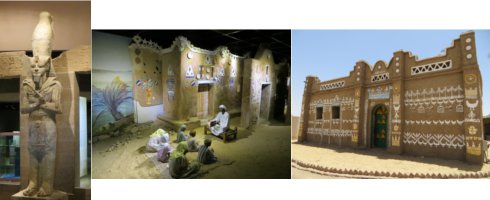

Unfinished Obelisk: this large stone was finished on three sides, but when a flaw on the rock was encountered it was abandoned and remained attached to the parent rock on the fourth side. We entered the exhibit not knowing what to expect and were unfortunately disappointed since there were only a large group of rocks and the unfinished stone.
Philae Temple (Temple of Isis): we took a short boat trip to arrive to an island where we this temple was relocated by UNESCO. It was taken apart stone by stone and moved to higher ground in order to save it from disappearing. With the massive stones this temple was one of our favorites in the country.
Elephantine Island: we spent a day wondering around this Nubian Island that played an important role as a trading center throughout the Pharaonic times. Now it hosts two villages with traditional houses and very hospitable people.
Aswan Museum & Abu Ruins: the museum itself was closed, but there were many ruins of the original town of Abu.

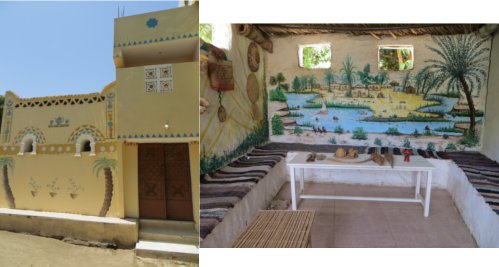
Animalia Museum: a family has dedicated part of their house to the traditions, flora, fauna, and history of Nubia. The museum exhibits a collection of stuffed animals found in Nubia, samples of sedimentary rocks, great pictures of Nubia before it was flooded by Lake Nasser, and a lovely roof terrace. In addition to the museum, the actual house is a traditional Nubian home. We were fortunate to be given a tour of the house by the daughter, Fatma, which not only gave us a tour but also talked about the history and politics of Egypt.
Felucca Ride
The Nile is Egypt’s lifeline, the artery that runs through the entire country, from south to north. By setting adrift on it we were able to appreciate its importance and its beauty. Sailing on a felucca, an Egyptian sailboat, is the slowest and most relaxing way to enjoy the river. During our felucca trip from Aswan to Kom Ombo, we spent two days sailing, jumping off the boat, swimming in the Nile, playing cards, eating delicious food, and seeing the stars at nights.

Sailing in a Felucca on the Nile River
Kom Ombo
Kom Ombo Temple: in ancient times sacred crocodiles basked in the sun of the riverbank near this temple. The temple is dedicated to the local crocodile god Sobek and Haroeris. In the temple confines, there is also a small museum where we were able to view mummified crocodiles that were found in and around the temple.
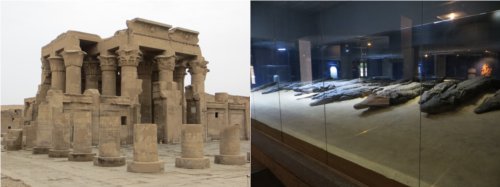
Luxor
Karnak Temple: we were fortunate to roam through this gigantic religious complex full of sanctuaries, kiosks, pylons, large columns, and obelisks dedicated to the Theban gods. The main structure, Temple of Amun, is one of the world’s largest religious complexes and the most important place of worship in Egypt during Pharaonic times.

Luxor Museum: in this wonderful museum we saw beautifully displayed collections of Egyptian sculptures.
Medinat Habu: this temple was completed by Ramses III and displays some of the deepest hieroglyphic carvings.
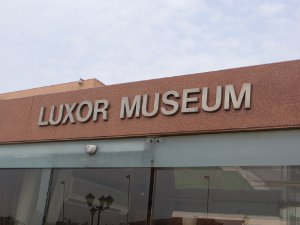
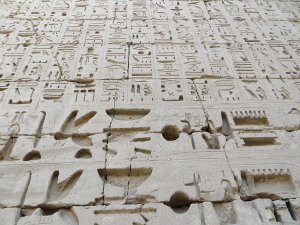
Deir al-Medina: built between 221 and 116 BC, this temple was dedicated to Hathor, the goddess of pleasure and love.
Artisan Tombs: we visited the Tomb of Inherka and Sennedjem, which are very well preserved and full of colorful decorated paintings. The tombs belonged to the artisans and servants that worked on the big king tombs. It is believed that they would work on their tombs during their days off. Unfortunately, we cannot share the beauty of the tombs since photography is prohibited to preserve the ancient sites.
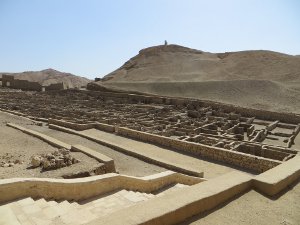
Tombs of the Nobles: there are more than 400 tombs belonging to nobles from the 6th dynasty to the Greco-Roman period. The nobles decorated their tombs with wonderfully detailed scenes of their daily lives. Not all the tombs are open to the public, but we were able visit the tombs of Sennofer and Rekhmire.
Memorial Temple of Hatshepsut: at a distance, we had a spectacular panoramic view of this temple set on the foothills of dramatic rugged limestone cliffs.

Valley of the Kings: this valley has 63 magnificent royal tombs from the New Kingdom period. All of them are very different from each other, but not all available for viewing. This burial site was chosen due to its secluded nature, enclosed by steep cliffs it was also easy to guard, and when seen from the Theban plain, it appears to be the site of the setting sun, which is associated with the afterlife by ancient Egyptians. We visited the tombs Ramses IV, Merenptah, Tawosret/Sethnakht, and Ramses VI.
Luxor Temple: we visited this temple in the evening and were fascinated by the great illumination. This temple with its different construction phases is a great example of all the empires that have ruled in this area. In this once Egyptian monument, you could see evidence of Greco-Roman architecture, Coptic Christian church, and the most recent addition a Muslim mosque that is still in use.
Cairo
Egyptian Museum: this museum host’s one of the world’s most important collections of ancient artefacts. The highlight of the museum was by far the precious mask of Tutankhamun (King Tuts), other highlights included the Amarna Room, Royal Tombs of Tanis, and the Animal Mummies.
Midan Tahrir: translated as Liberation Square, it is the site where millions of Egyptians converged, in 2011, in a peaceful revolution to oust then-president Hosni Mubarak. On any other day, it is just an average giant traffic circle.

Al-Azhar Mosque: located in Islamic Cairo, this mosque is beautiful from the inside and out. Founded in AD 970, Al-Azhar is one of Cairo’s earlier mosques.


Mosque of Sayyidna al-Hussein: one of the most sacred Islamic sites in Egypt, this mosque is the reputed burial place of the head of Hussein, the grandson of the Prophet. Umayyad Mosque in Damascus claims the same Shiite relic. The site is so holy that non-Muslims are not allowed inside.
Khan al-Khalili Market: walked around this chaos that has been taking place in this market since the 14th century and continues to be the first choice for thousands of locals to do business.

Wikala of Al-Ghouri: enjoyed a great sufi performance by Al-Tannoura Egyptian Heritage Dance Troupe in the courtyard of this venue. You can catch a short glimpse of the colorful presentation in the video provided.
Sufi Dance Performance in Wikala of Al-Ghouri
Coptic Museum: this museum, founded in 1908, houses Coptic art from the earliest days of Christianity in Egypt up through early Islam.
Roman Towers: walked by these towers that are the only remains of a Roman fortress built by emperor Trajan in AD 98.
Hanging Church: this church received its name because it is suspended over the Water Gate of Roman Babylon.
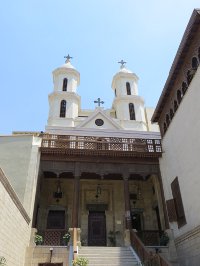
Church of St Sergius & Bacchus: this is the oldest church inside the walls of Coptic Cairo, built in the 11th century. It is built over a cave where it is believed that Joseph, Mary, and the infant Jesus are said to have taken shelter after fleeing to Egypt to escape persecution from King Herod of Judea.

Ben Ezra Synagogue: this 9th-century synagogue is believed to be the spot where the prophet Jeremiah gathered the Jews in the 6th century after Nebuchadnezzar destroyed the Jerusalem temple. The adjacent spring is supposed to mark the place where the pharaoh’s daughter found Moses.
Greek Orthodox Monastery & Church of St George: the church and monastery was closed, but we were able to view the complex from the exterior. St George is one of the region’s most popular Christian saints
Mosque of Amr ibn al-As: we entered the first mosque built in Egypt, established in AD 642 by the general who conquered Egypt for Islam.
The Citadel: a complex of mosques and other structures. The highlight of our visit was the Mosque of Mohammed Ali, modelled on classic Turkish lines with domes upon domes. The interior is twinkling chandeliers and the main dome is a rich emerald green.

Pyramids of Giza: three pyramids and the Sphinx compose this complex of amazing man-made structures. It is now known that they were massive tombs constructed on the orders of the pharaohs by teams of workers. Evidence has been discovered that the workers were not the slaves, but an organized workforce of Egyptian farmers that during the flood season the same farmers could have been redeployed to work on the pharaoh’s tomb. The Sphinx was carved from the bedrock and sometime between the 11th and 15th centuries the nose was hammered off.
Pyramids of Giza
Dahshour Temple: it is believed that 11 pyramids once stood in this area, but now only two remain. We were able to walk down many steps to enter one of the pyramids and witness the beautiful stone construction from the inside.
Saqqara Temple: the huge cemetery of ancient Memphis was an active burial ground for more than 3500 years and is Egypt’s largest archaeological site. We were able to see a unique Step Pyramid, which is believed to be one of the first pyramids built by the ancient Egyptians.
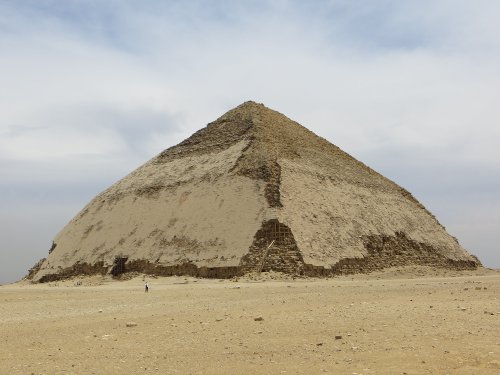
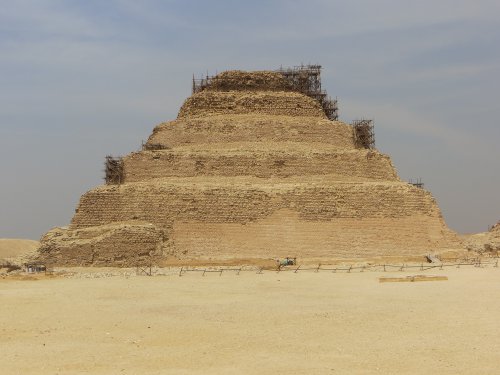
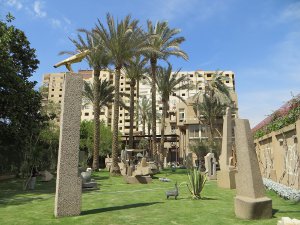
Adam Henein Museum: we were fortunate to meet the Egyptian sculptor Adam Henein in his museum and received a personal tour. The museum represents a recompilation of the artist life of creativity. Henein has received numerous awards for his work, which has been exhibited in Egypt, the Arab world, Europe, and New York’s Metropolitan Museum of Art.
St. Katherine
St. Katherine Monastery: this ancient monastery traces its founding to about AD 330, built beside what was believed to be the burning bush from which God spoke to Moses. In the 6th century, a fortress was constructed around the original chapel, together with a basilica and a monastery, to provide a secure home for the monastic community that had grown here.
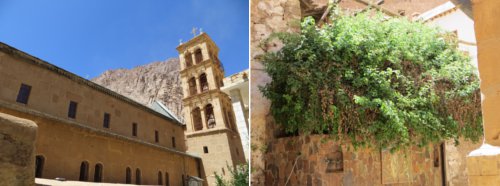
Mt. Sinai: this mountain is revered by Christians, Muslims and Jews, all of whom believe that God delivered his Ten Commandments to Moses at its summit. We had a very early start, waking up at 12:30am to walk towards the entrance, to ascend Mt. Sinai. The total journey lasted seven hours and we were able to view the sunrise from the summit.

Dahab
Scuba Diving in the Red Sea: our primary purpose to visit this region was to be under the Red Sea!! We took a boat out to Gabr el-Bint and submerged twice. We were left speechless (literally!!) viewing the beautiful coral cliffs and colorful fish. We saw a huge barracuda, scorpion fish, and so much more!! Be sure to read our article to see more pictures and learn of our experience.
